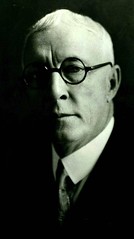
PREV ARTICLE
NEXT ARTICLE
FULL ISSUE
PREV FULL ISSUE
MORE ON CLIFFORD HEWITT
Last week Bruce Smith asked for information on Clifford Hewitt (1869-1942).
-Editor
Jan Monroe asks: Was Clifford Hewitt related to Lee Hewitt, editor of the Numismatic Scrapbook?
If so, that fact hasn't surfaced yet.
-Editor
David Hill, Archivist of the American Numismatic Society writes: We have a small collection relating to Hewitt in the ANS Archives. http://numismatics.org/Archives/Chewittbio# . Among other things, it contains correspondence and biographical information, some of which has been incorporated into the collection description. I would be happy to provide Mr. Smith with more information, if he'd like to get in touch. Regarding Hewitt's activities after the Shanghai Mint, this is from a biographical sketch in the collection: "He held the position and title of technical mint expert throughout his 12 years of service in China until March 1933 when he retired to his home in San Diego." As for Hewitt's full name, I haven't encountered the use of an initial or anything fuller than "Clifford Hewitt" in his official correspondence or elsewhere.
Below is an excerpt from the ANS archives web page.
-Editor
Hewitt was the son of Isaac Hewitt and grandson of Thomas Hewitt, both early railroad engineers. Clifford began his training with the Janesville Ironworks in Pennsylvania and went on to graduate from the Franklin Institute of Mechanical Engineering in Philadelphia in 1893. He oversaw the design and building of the Manila Mint, the only U.S. mint established outside of the continental United States, and was then contracted by the Chinese government to serve as technical mint expert for the Shanghai mint project, a position he held from 1920 to 1933, the year the mint opened. He later retired to San Diego. To read the complete archive entry, see: Clifford Hewitt Chinese Mint collection, 1930-1934 (numismatics.org/Archives/Chewittbio) NBS Board Member Marc C. Ricard writes: I was able to find a few more details. After reading that Mr. Hewitt retired to San Deigo, a quick check of the California Death Record archive for 1942 reveals that there was no middle name or initial in the record, and that it appears that Clifford was indeed his first name. He died on October 11, 1942. I was unable to find an obituary in the archives of any San Diego newspapers around that date, that was available free of charge. If someone in our community has a membership to Ancestry.com, those records may be available there. Bruce Smith adds: I should have mentioned that I already knew about the Hewitt Collection at the ANS. In fact, it seems I know more about it than they do. Here is an outline. At some point after he left the Shanghai Mint in 1933, Clifford Hewitt retired to San Diego, California. His collection was acquired by San Diego coin dealer, Edward P. Janzen, probably in the late 1960's. According to R. B. White, Janzen was a US Army officer serving in China at the end World War II, and was one of the first Americans to enter Peking at the end of the war. Sometime after the war, Janzen settled in San Diego. Janzen put together an exhibit of the Hewitt collection for the 1971 ANA convention in Washington DC. The collection was photographed by professional numismatic photographer, Larry Stevens, and a story about the collection, with some of Stevens' photos, was published in CoinAge magazine December 1971. Janzen sold some items out of the collection, probably before it was exhibited. R. B. White bought examples of the copper coins in the collection. Janzen consigned the exhibited collection to the Superior sale at the 1975 ANA, where it was listed as one lot with a three page description. The lot sold for $7,500 -- apparently to dealer Frederick S. Werner, who donated it to the ANS in 1977. Another article about the collection, by Chang Kan-sheng, was published in Chinese in Numismatic World Bimonthly #3 (May 1977). This article contained additional images, including a letter dated 10 November 1931 from Philadelphia Mint engraver, John Sinnock, to Hewitt, discussing problems they had producing dies for the Shanghai Mint. Trial strikings were made of several different coins. The Werner donation was noted in the 1977 ANS annual report, with a photo of a Shanghai Mint Completion medal and half of a Yuan Shih Kai dollar which was handstamped "Hangchow 1921 No.4." The other half of this coin was apparently used for assay purposes. Hangchow was one of the mints which struck the Yuan Shih Kai dollar before the Shanghai Mint opened. The ANS report says 27 items were in the collection given to the ANS, but this must be the number of coins and medals, in addition to the documents, letters, photographs and sketches.
To read the earlier E-Sylum article, see:
QUERY: INFORMATION ON CLIFFORD HEWITT (1869-1942) SOUGHT
(www.coinbooks.org/esylum_v14n19a08.html)
The Numismatic Bibliomania Society is a non-profit organization promoting numismatic literature. See our web site at coinbooks.org. To submit items for publication in The E-Sylum, write to the Editor at this address: whomren@gmail.com To subscribe go to: https://my.binhost.com/lists/listinfo/esylum All Rights Reserved. NBS Home Page Contact the NBS webmaster 
|
